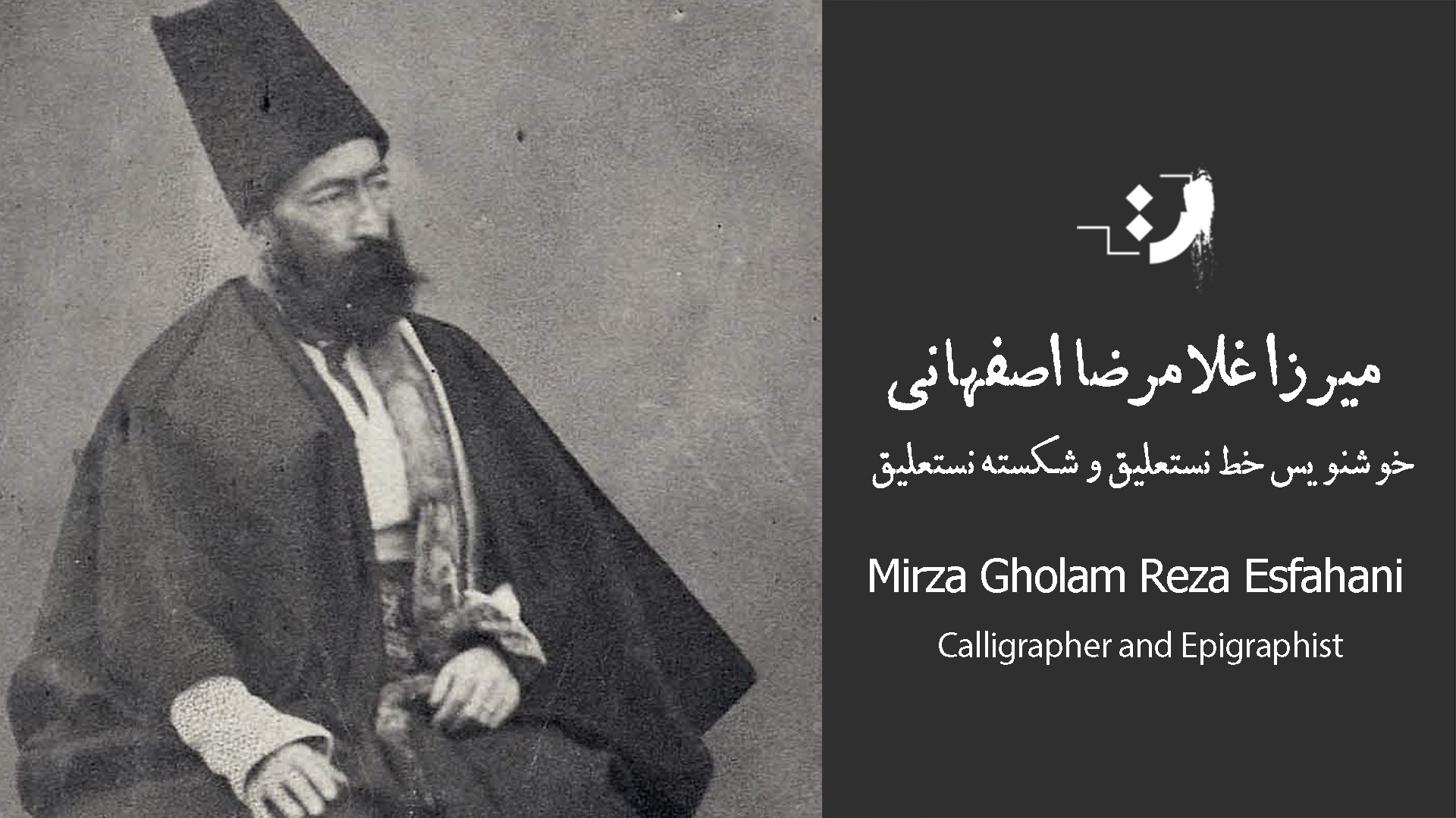Mirza Gholam Reza Esfahani

Biography
Mirza Ghulam Reza Isfahani (1246-1304 AH) was one of the Iranian masters of calligraphy, specializing in Nastaliq and Shekasteh Nastaliq scripts. Mirza Ghulam Reza was one of the most renowned calligraphers of the Qajar period. His father’s name was “Mirza Jan,” and in his youth, he served in the court of Mohammad Shah and later in the court of Naser al-Din Shah.
Ghulam Reza’s father came to Tehran from Isfahan in 1212 AH and engaged in confectionery. Therefore, he named his son Ghulam Reza, believing it was due to seeking the intercession of Imam Reza, the eighth Imam of Shia Muslims.
Mirza Ghulam Reza has been described as a mystical person, a literary figure, and a man of deep meaning. He began attending school at the age of five and mastered reading the Quran within two years. He attributed his calligraphy skills to “the grace of Almighty God,” describing it not as self-acquired but as a manifestation of divine favor.
In his memoirs, Mirza recounts visiting Imam Ali, the first Imam of Shia Muslims, in a dream at a young age, which significantly changed his life. In a piece written in broken Shekasteh script, he describes this experience and its impact on his life.
Afterward, Mirza Ghulam Reza studied under Seyyed Ali Hakkak Tehrani, the father of the famous calligrapher Mir Hossein, to learn calligraphy. By the age of nine, he had become known for his excellent handwriting skills. Throughout his relatively short life, he created numerous works, some of which are considered national artistic treasures in Iran.
He was accused of practicing witchcraft, as it was believed that his intercession with a nobleman or one of Naser al-Din Shah’s sons saved him from the king’s wrath and death.
Mirza Ghulam Reza, who married late in life, became a father at the age of 54 in 1300 AH when his son Mohammad Reza was born. However, Mohammad Reza fell ill at the age of three and passed away suddenly, causing great grief to Mirza, who expressed a wish for death. He eventually passed away on the fourth of Rabi’ al-Thani 1304 AH, fulfilling his wish for death. He was buried in the garden of Mirza Hossein Khan Sepahsalar, near Haj Mirza Safa’s shrine in Cheshmeh Ali, Rey.
In his youth, Mirza Ghulam Reza was summoned to the court of Mohammad Shah Qajar. Mohammad Shah, who himself was proficient in Nastaliq calligraphy, admired his handwriting and appointed him as a tutor for his children. Even after Mohammad Shah’s death, Naser al-Din Shah continued to value him.
Mirza Ghulam Reza is one of the few calligraphers who mastered both Nastaliq and Shekasteh Nastaliq scripts with complete mastery and developed his own unique style in both. His style in calligraphy is one of the most robust and powerful, and his manuscripts, inscriptions, and calligraphic pieces rank among the top works in both Shekasteh and Nastaliq scripts.
One of his notable contributions to calligraphy was the composition of letters and words. As he was one of the most famous calligraphers during his lifetime, many commissioned him to write various works, some of which he entrusted to his students (such as the tiles surrounding the tomb of Sheikh Sadooq Ibn Babuyeh, which he entrusted to Mohammad Ibrahim Tehrani). He also wrote numerous works himself, which are considered among the most significant calligraphic works in Iran.
His signature often included the phrase “Ya Ali Madad” (O Ali, Help), but in some pieces, his full name alongside “Ya Ali Madad” appeared, while in others, only “Ya Ali Madad” or “Ya Ali Madadi” without his name was written. In some pieces, the signature appeared as “Al-Abd Al-Mudhnab Al-Faqir Al-Haqir Ghulam Reza Ghafarallah” (The sinful servant, the humble and poor, Ghulam Reza, may God forgive him), followed by “Ya Ali Madadi,” or in a similar format.
His works transcended both time and place, with many calligraphy enthusiasts owning pieces of his work. The renowned calligrapher “Sang,” a prominent Chinese calligrapher, was deeply moved by one of Mirza Ghulam Reza’s pieces displayed in the Hangzhou Exhibition in Beijing, shedding tears slowly but continuously as a sign of respect with a coarse calligraphy pen, he inscribed: “Mirza Ghulam Reza Isfahani, the Greatest Calligrapher in the World.”
- Birthday: 1830
- Death: December 31, 1886
- Birthplace: Isfahan, Isfahan, Iran
Calligrapher and Epigraphist
